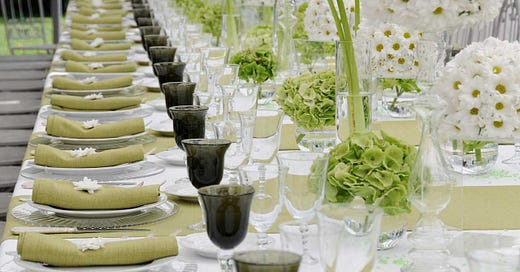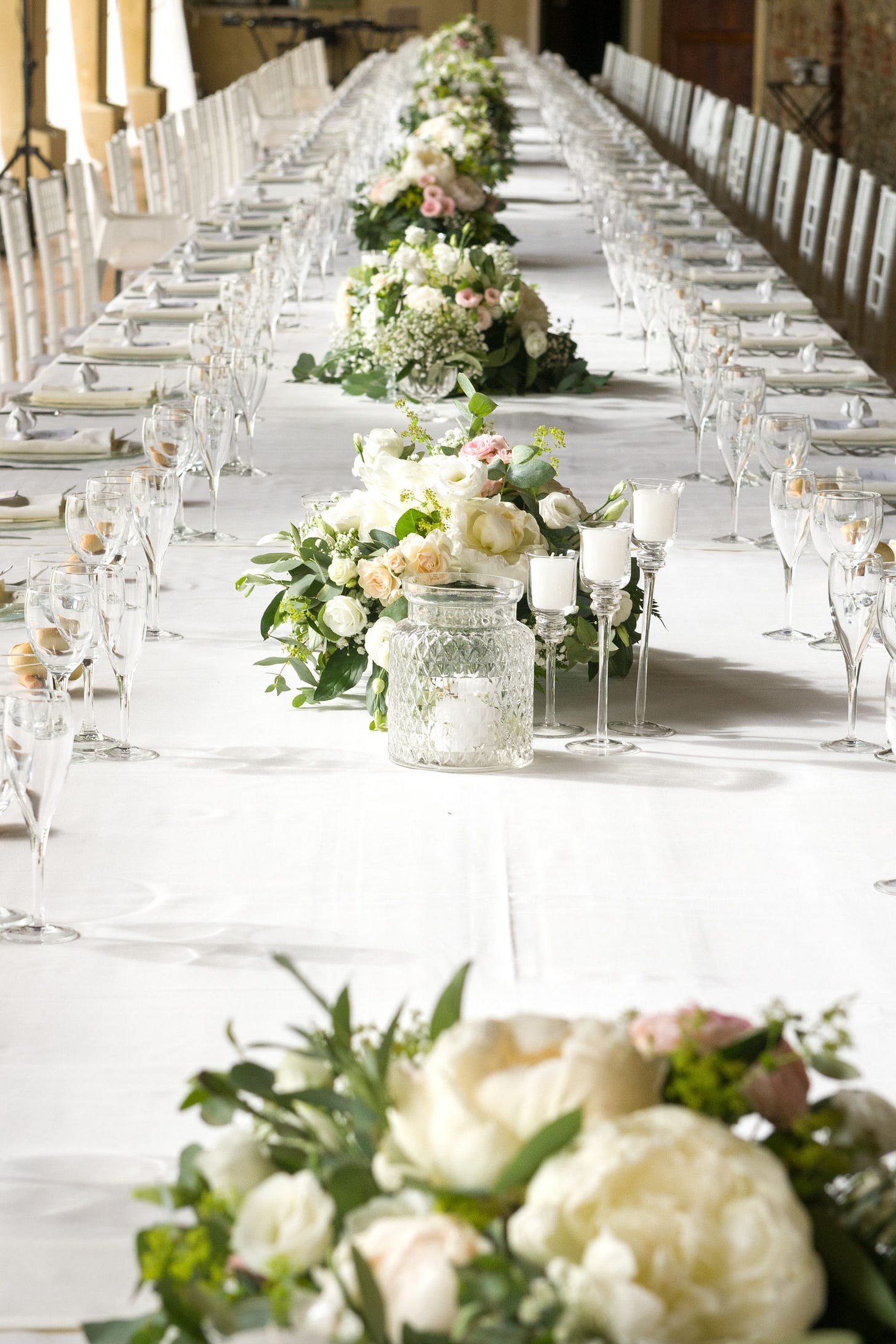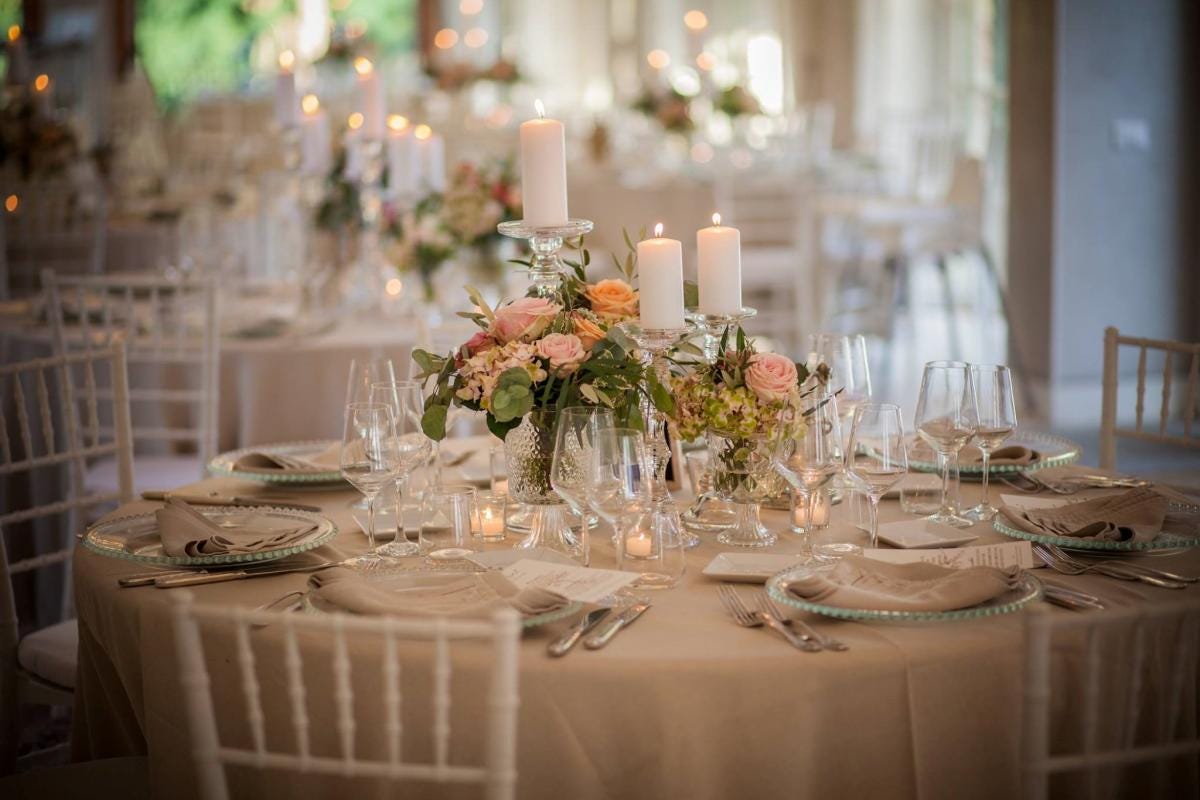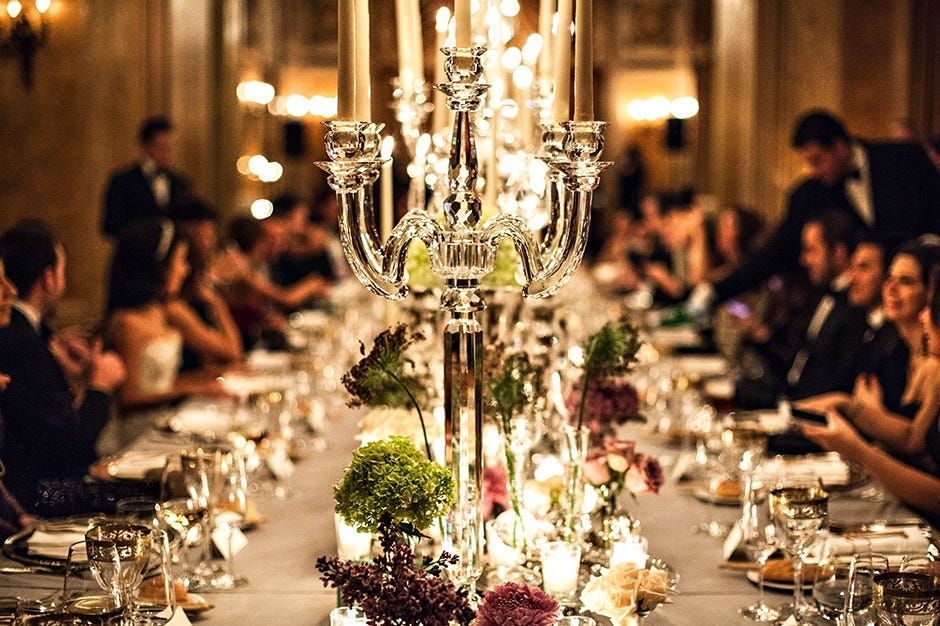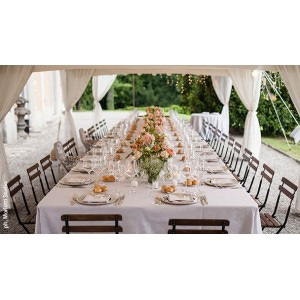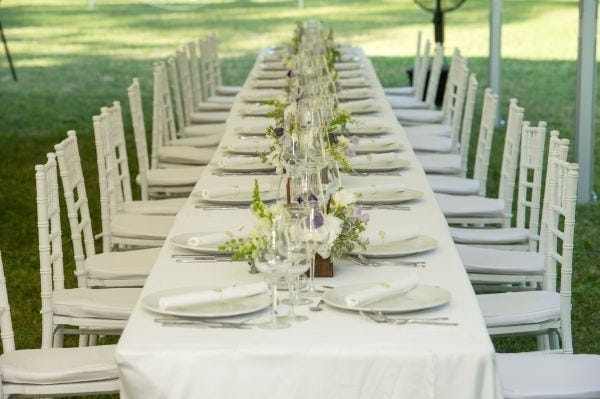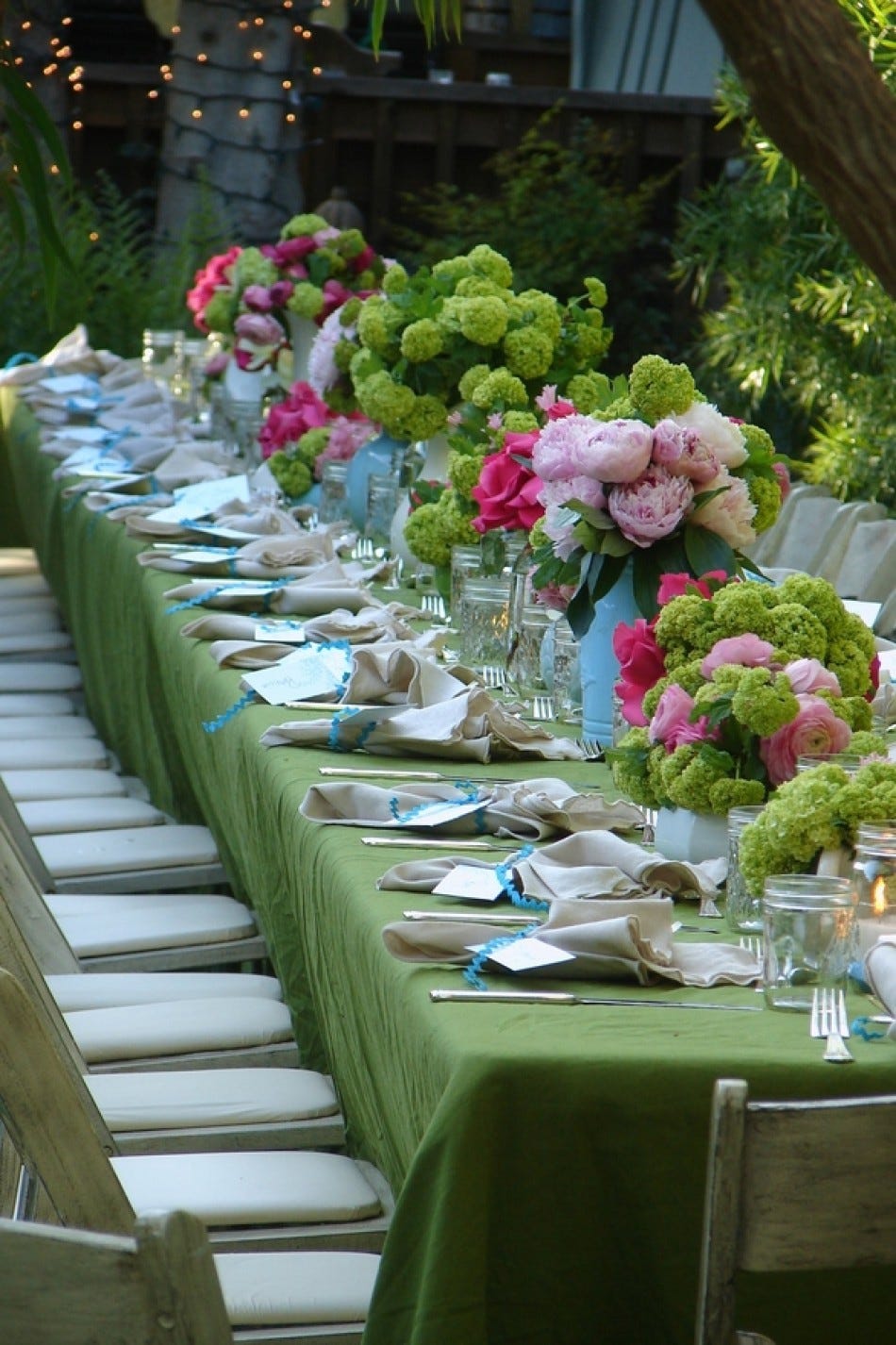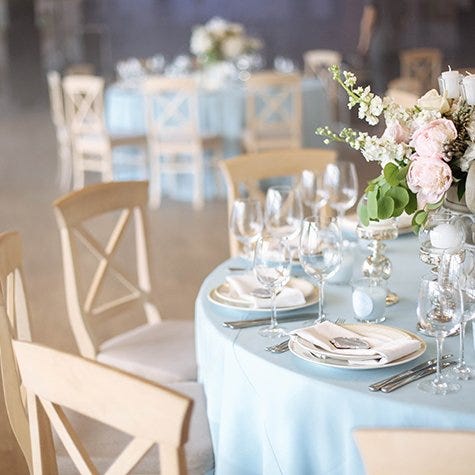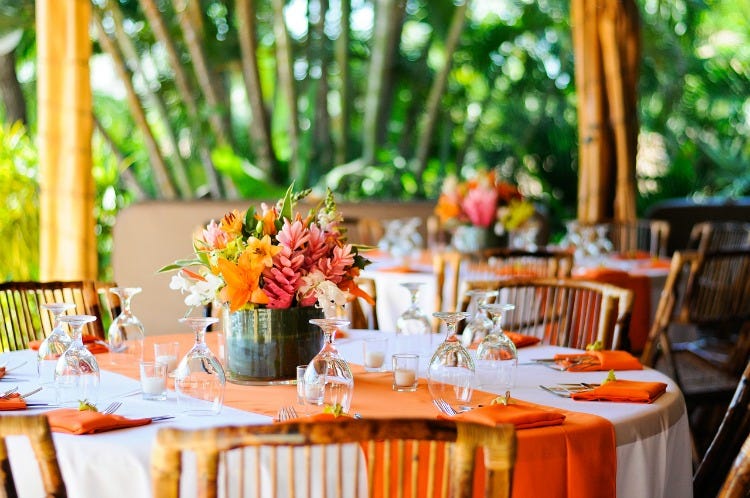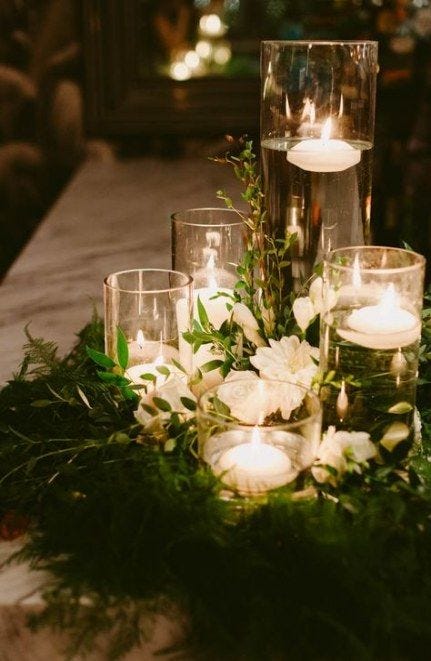Let’s continue with the wedding reception topic, going into the details of the table setting, which I already mentioned last Sunday.
When you imagine the wedding reception with its banquet, you must immediately decide whether you want to have a single table, called “imperial table”, or several separate tables.
The imperial table is an elongated table that can take different shapes. It can be made in a "T" shape, a "U" shape (horseshoe), and so on and so forth, but the only thing that unites them all is the purpose, which is to get all the diners together at one table. Additionally, it is also advisable to take into account the scenic factor, the utility, the comfort and the space within which the set-up is to be done.
In many cases, however, the choice of the table is dictated by external factors that have nothing to do with utility. Take for example an event venue that doesn't have imperial tables and doesn't even intend to rent them. The answer to the question addressed to the organizers on whether to have a nice imperial table may then be "I don't think an imperial table is a good choice" or "we don't have enough space" or even "it distracts the concentration from the newlyweds". It is not enough to put 5/6 tables together to create an imperial table, as a very articulated reasoning must be made on the dimensions and the actual setting of the tables.
Also, it is not always possible to set up a long and linear table based on the declared number of guests. In some cases the rooms can even be too small to set up a large table. In other cases, some villas for receptions or catering do not have this equipment available and therefore the phrases stated above often sound like an excuse for a lack of upstream organization.
That said, why choose the imperial table?
The choice is basically made for two reasons: utility and beauty.
Those who opt for this type of solution focus on the scenic factor of the set-up. But it may be that the choice falls on this solution for other aspects. The first to take into consideration is the width of the room chosen for the banquet. A very narrow room cannot contain round tables divided into groups because, in addition to the space of the table, the space of the chairs and the area between one table and another must also be taken into account.
How to set up the imperial table.
The set-ups depend on the width of the table. In fact, there are imperial tables of 2 widths.
1. Imperial table 70 cm wide (27 inches)
2. Imperial table 140 cm wide (55 inches)
The length can be decided according to the places to be added.
If space allows it, it is better to choose the 140 cm table because it allows rich floral compositions to which it will be possible to add other decorative elements (candles, candelabra, candle holders, place cards, etc). The wide table also allows you to prepare a complete mise en place.
The 70 cm wide table should be chosen for settings where there is no need to make large flower arrangements, the most minimalist yet still elegant ones.
It goes without saying that the two settings also have completely different rates, and not just for the table itself: they can even double, in some cases.
Once you have chosen the table, you have to think about everything that is placed on and around:
- elongated and continuous flower arrangement
- charger plates
- tablecloth
- napkins
- runner or stain cover
- candlesticks
- candle holder with snot
- chairs
- various candles
Floral arrangements for the imperial table.
Essentially, the compositions can be made in two different ways: the first solution is to make single centerpieces, perhaps placed alternating high and low with candles in the middle. They can be made in pots or more naturally arranged asymmetrically placed directly on the table. This solution has increasingly lower costs than the next one.
The second solution, on the other hand, consists in creating a single central composition that is very rich and maximum 30/35 cm high. It is far from cheap but very impressive.
Tablecloths for an imperial table.
The tablecloth that is normally placed on imperial tables is of cotton or linen. The width of the tablecloth is dictated by the type of table that you choose. Prices vary according to the length and the type of fabric chosen.
There are two different ways to cover a table. The first, the most used one, consists in connecting several tablecloths to get to the desired length and to hide the seams, runners or stain covers are used. The second method is the choice of the single tablecloth that must be prepared in relation to the length of the table. In this way you will have a single tablecloth without using runners, stain covers and various expedients to avoid noticing the attachment. Although no one will ever notice the attachment with everything that is then put on the table.
The single round table: why choose it and what are the comforts.
The vast majority of events are made with round tables. Why?
The round table is the most practical solution, the one that is adopted in many ceremonies. The villas for events, in fact, are equipped with these tables of various sizes. There are 4 different sizes:
1) table for 4/6 seats, diameter 120
2) table with 6/8 seats, diameter 150
3) table with 8/10 seats, diameter 160
4) table with 10/12 seats, diameter 180
The most used size is N ° 3, which holds 8/10 seats.
The round standard table can be individually decorated with a theme, thus creating a sequence of different tables but all united by a common thread: they will then be set up following the chosen theme but changing the tablecloths, cutlery, flower arrangements, color and chairs.
For example, you can choose the theme "nature or season" and have the tables set up in this way;
1 SPRING table: apple green tablecloth, transparent placemat, place card with a spring flower, colorful bush-shaped centerpiece, white chairs, colored glasses in green glass.
2 AUTUMN table: brown tablecloth, centerpiece with pumpkins and autumn flowers, place card with an autumn fruit, gray placemat, brown wooden chairs, plum-colored glasses and so on for all tables.
Following this scheme, the cost of each table will be individual and will certainly not be the same price for 10 tables made all the same. Prices change because first of all you have to take into consideration the type of flower to use. Today it is possible to order all the flowers even out of season, but sometimes at a prohibitive price.
So, have you chosen between the imperial table and separate tables?
Until next Sunday

